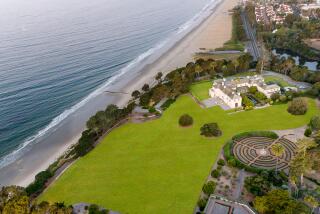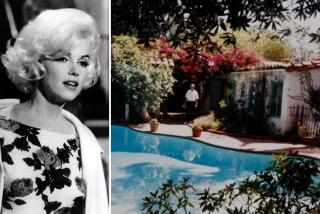Mansion Opens Doors Into Victorian Lifestyle : Landmark: The Biltmore Estate offers tailored grounds and works of art. But thousands of tourists now pick up the tab.
- Share via
ASHEVILLE, N.C. — When George Vanderbilt first visited North Carolina’s Blue Ridge Mountains more than a century ago, he envisioned living there in a country estate in the tradition of the chateaus of France’s Loire Valley.
By 1890, the wealthy grandson of one of America’s foremost entrepreneurs, Commodore Cornelius Vanderbilt, had acquired more than 125,000 acres of forest around the city of Asheville.
Five years and untold millions later, the 33-year-old bachelor moved into his lavish 250-room Biltmore Estate. With four acres of floor space, the limestone mansion remains the largest private home in the United States.
The Biltmore remains in the hands of the family today, but no one lives there.
Instead, William A. V. Cecil--Vanderbilt’s grandson who grew up in the mansion--is host to more than 700,000 visitors a year who pay nearly $20 each to step back in time and see how the rich and famous lived during the Victorian Era.
Cecil, who returned to the Biltmore 30 years ago, depends on those visitors to cover the expenses of maintaining the estate.
Cecil and his staff have gone to painstaking efforts to make sure the home looks as if the Vanderbilts still live in it today.
An art lover, Vanderbilt filled the home with 70,000 objects, including 16th Century Flemish tapestries, a chess set once owned by Napolean and paintings by Renoir and John Singer Sargent.
“The collection is very eclectic,” said curator Susan Ward. “It represents his own tastes rather than following the trends of the times. The books in the library were ones in which he was interested.”
Outside, the formal French and Italian gardens and the grounds would still please the eye of landscape architect Frederick Law Olmsted, who also designed New York’s Central Park.
When he died, Vanderbilt gave most of the undeveloped land to the federal government, and it became the Pisgah National Forest. Today, the house stands on about 250 acres of gardens, parklands and woods.
The estate also has a working winery, which opened in 1985. But it’s George Vanderbilt’s country estate that pulls in tourists from all over the world.
Passing through the front gate, it takes several minutes to drive up the twisting approach road though thickets of pine, dogwood and rhododendron. The charming, 3-mile roadway was designed by Olmsted to give Biltmore’s visitors a sense of anticipation.
The first impression of the house is overpowering. The four-story limestone French Renaissance chateau rises from its perch in front of majestic Mt. Pisgah.
Vanderbilt, a scholarly man who spoke eight languages, combed the countryside of France before deciding on an architectural style for his dream home.
On his journey, he took along his friend, Richard Morris Hunt, who was the first American to receive a degree from the Ecole des Beaux Arts in Paris.
Vanderbilt decided the house would be in the tradition of the great 16th-Century chateaus of France, which were known as a Francis I style.
“Vanderbilt was very involved in every aspect of the house,” Ward said. “He’s seen in every photo taken during the construction.”
Construction was slow and expensive. Vanderbilt put in a railroad spur to cart in hundreds of tons of Indiana limestone. Oak was shipped in and milled on the site. Bricks were made from clay found on the grounds.
After five years, the Biltmore opened on Christmas Eve in 1895. Vanderbilt himself took the presents from the 40-foot-high tree to give to his family, friends and servants.
Today, gargoyles and cherubs carved out of the limestone greet guests at the Biltmore’s front door, which opens into a large marble entrance hall.
Immediately to the right is the winter garden, with its assortment of flowers, palms and ferns getting plenty of sunlight through its greenhouse-style roof.
A statue of a boy and geese by Austrian sculptor Karl Bitter is the garden’s centerpiece. The winter garden was the setting for the 1924 wedding luncheon for Vanderbilt’s only daughter, Cornelia. The luncheon was attended by 1,000 guests.
Tucked around the corner is the bachelors’ quarters, where unattached male guests could play billiards and smoke cigars under enormous animal trophies. An interesting feature is the set of hidden doors that blend into the wood paneling.
In every room, the Vanderbilt family crest--acorns and oak leaves--can be found.
Despite its 72-foot ceiling and dining room table that seats 64 guests, the acoustics in the banquet hall are so good that conversations can be held from opposite ends of the room.
The only portrait of Vanderbilt hangs in the tapestry gallery, where three large 16th-Century Flemish tapestries are on display.
The next room was the owner’s favorite--the oak-lined library with its 22,000 volumes and an enormous Pelligrini painting that covers the entire ceiling.
Upstairs, Vanderbilt’s south bedroom offers a spectacular view of the grounds, with the French Broad River and Mt. Pisgah in the background.
Down the hall is the oval-shaped bedroom where Vanderbilt’s wife, Edith, slept. It’s decorated with Louis XV-style furnishings.
It takes several hours to tour the Biltmore, which has 32 bedrooms, a heated indoor swimming pool, a bowling alley and a gymnasium. Downstairs is the kitchen and quarters for the estate’s 80 servants.
The Biltmore was equipped with the most modern conveniences of the day, including indoor plumbing, central heating, refrigeration and electricity.
In hopes of making the estate self-sustaining, Vanderbilt opened a dairy, cultivated grapes for wine and grew crops for his cattle and horses.
Crops are still grown near the French Broad River, which flows on the southern edge of the grounds. The vineyard is located just across the river.
Cecil says the biggest challenge right now is finding ways to handle all of the people who want to see the house. Parts of the house that had never been seen by the public have been opened in recent years.
Part of the challenge is retaining the Biltmore’s charm with its growing guest list.
“My grandfather didn’t expect 700,000 friends a year flushing his toilets,” Cecil said.
More to Read
Sign up for The Wild
We’ll help you find the best places to hike, bike and run, as well as the perfect silent spots for meditation and yoga.
You may occasionally receive promotional content from the Los Angeles Times.






